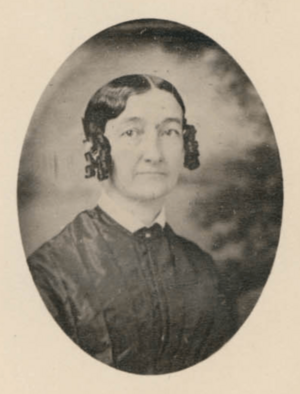Abigail Kimber facts for kids
Quick facts for kids
Abigail Kimber
|
|
|---|---|
 |
|
| Born | 1804 |
| Died | March 22, 1871 |
Abigail Kimber (born 1804, died March 22, 1871) was an amazing American woman. She was a botanist (someone who studies plants), a plant collector, and a strong supporter of social change. She fought to end slavery and for women to have equal rights.
Contents
Abigail Kimber's Early Life
Abigail Kimber, often called Abby, was born in Philadelphia, Pennsylvania, in 1804. Her parents, Emmor and Susan Kimber, were Quakers. They ran a girls' boarding school called Kimberton.
The Kimberton School
Kimberton School was very important in Pennsylvania during the 1830s. It focused on training students to become teachers. Abigail, along with her sisters Mary and Martha, taught at the school. Abigail started teaching when she was just 14 years old! By the 1820s, she was in charge of the school's lessons.
Kimberton was special because the Kimber family believed in making society better. They often involved their students in important movements. For example, Abigail took students to meetings about the temperance movement. This movement encouraged people to drink less alcohol.
Inspiring Others
Many students loved Abigail and found her inspiring. One student, Gertrude K. Wilson, said that the school taught them "a love of right and hatred of wrong." This made them strong supporters of ending slavery. Abigail taught at Kimberton for 30 years, helping many young women.
Fighting for Change
Abigail Kimber was a dedicated anti-slavery activist. This means she worked hard to end slavery. She was a key member of the Philadelphia Female Anti-Slavery Society, serving as secretary, vice president, and even president. She also worked with the Pennsylvania Anti-Slavery Society.
Standing Up for Women
In 1840, Abigail traveled to London for the World Antislavery Convention. However, she and other women delegates were not allowed to join the main meetings. They were told they couldn't be members because they were women.
Even though they were excluded, Abigail and the other women still debated important ideas. They discussed "the Woman Question," which was about women's rights and their role in society. Abigail never stopped fighting for freedom for both men and women. She continued to work for the abolitionist movement and women's rights throughout her life.
Abigail Kimber once wrote a letter protesting how women were treated at the convention. She said that the men had "unwittingly done deep wrong" to many abolitionists in the United States by excluding women. She wanted them to show a "conciliatory spirit" and fix their mistake.
Studying Plants
Abigail Kimber taught chemistry and botany (the study of plants) at Kimberton School. One of her students, Graceanna Lewis, later became a natural history teacher herself.
Abigail also became well-known as a plant collector. She was one of the first people to donate plant and mineral samples to the Delaware County Institute of Science. In 1834, she gave them samples of "Brown hematite" (a type of mineral) and a shrub.
She sent her plant and mineral collections to William Darlington, a famous botanist. He included her findings in his books about plants in Chester County, Pennsylvania. In his 1853 book, William Darlington even suggested that teaching botany to women was a great way to spread scientific knowledge. He was likely inspired by women botanists like Abigail Kimber.
Later Life and Death
Abigail Kimber passed away on March 22, 1871, in Philadelphia, Pennsylvania. She was 66 or 67 years old.
See Also

